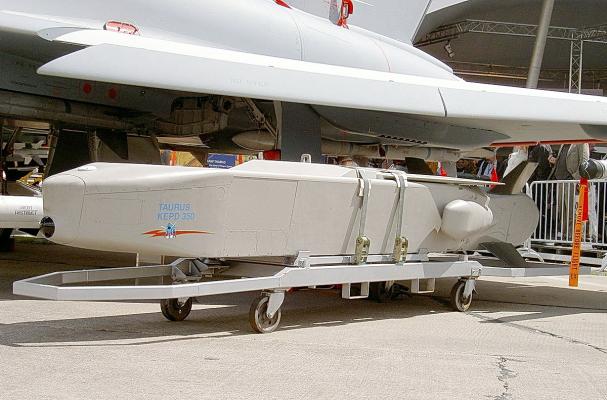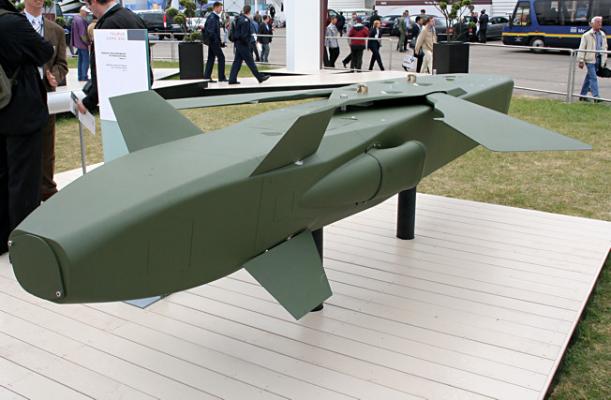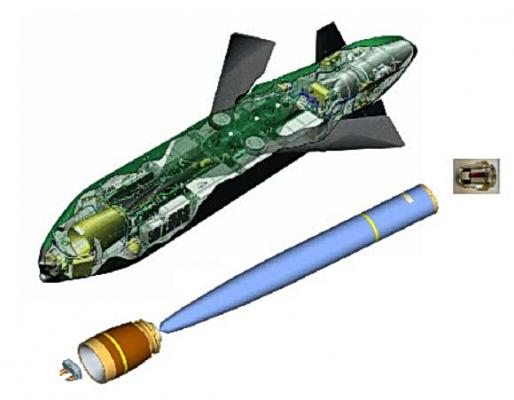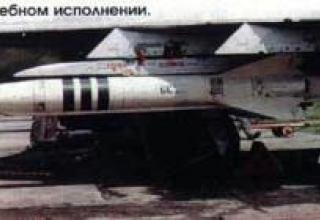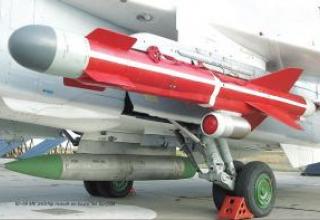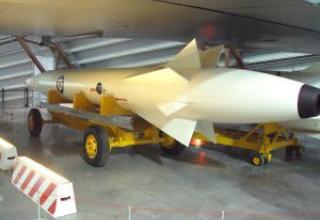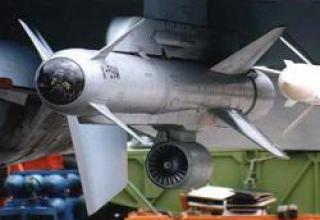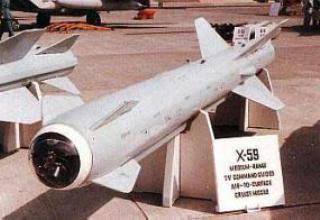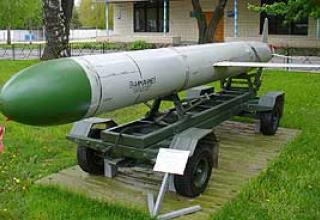The TAURUS KEPD 350 (Target Adaptive Unitary & Dispenser Robotic Ubiquity System / Kinetic Energy Penetrating Destroyer) long range cruise missile is designed to accurately engage protected targets without the carrier aircraft entering the enemy's air defense zone.
The missile was developed by Taurus Systems GmbH - a joint venture between MBDA Deutschland and the Swedish company Saab Bofors Dynamics AB. The development of the missile began in 1998, went at an accelerated pace and already in 2004 the KEPD 350 missile went on flight tests and was adopted for service.
On August 8, 2002, the German Federal Bureau for Defence Technology and Procurement concluded a contract with Taurus Systems GmbH for the supply of 600 TAURUS missiles and 14 training missiles for the Air Force (see photo). The cost of the contract is 570 million euros.
In November 2004, Spain became the first foreign client to order KEPD 350 missiles for the Spanish Air Force's EF-18A (C.15) and Eurofighter Typhoon aircraft. The main contractor for the supply and integration of TAURUS missiles with EF-18A and Eurofighter aircraft is SENER. On June 24, 2005, the Spanish government approved the purchase of 43 TAURUS KEPD 350 missiles for equipping the EF-18A and Eurofighter aircraft. The price of the contract was 57.4 million euros.
Work on improving the missile, its integration into modern weapon systems continues. According to the developer, the maximum range of the missile has been increased to 500 km. Currently, in addition to the basic version of the KEPD 350, Taurus Systems GmbH offers a family of modular missiles that have different combat equipment and can be used on different targets and from different carriers. The lightweight version KEPD-150 is designed to equip the Swedish Air Force's JAS-39 Gripen multi-purpose fighter (see photo). The TAURUS CL variant is offered for arming advanced frigates and destroyer squadrons of the German Navy.
It is reported that the TAURUS missile is equipped with a two-way data line, which will make it possible to use the missile against moving targets and to redirect it in flight.
Composition:
The TAURUS KEPD 350 rocket has a supporting body, a slightly extended top-opening wing and a cruciform tail fin with controls. In order to reduce radar visibility, the rectangular housing is made of composite materials, has no sharp edges at the interface points and is covered with a radio absorbent material.
On KEPD-350 the turbojet engine Williams International P8300-15 (draught 6,67кН) with two lateral air intakes is established. The curved inlet channels of the air intakes shield the engine turbine from the sighting by ground radars. Fuel tanks are located between the homing head and the engine on either side of the combat unit.
The Tri-Tec control system is combined:
- an inertial navigation system (INS) combined with the MIL-GPS satellite navigation system. The inertial navigation system is based on laser gyroscopes developed by Northrop Grumman LITEF;
- TRN (Terrain Reference Navigation) terrain contour navigation system using high-precision radar altimeter ;
- electronic-optical correlation subsystem IBN (Image Based Navigation) with correction on the basis of digital maps of pre-recorded terrain along the CR flight route. The number of trajectory correction areas - up to 10;
- Thermal imaging head of homing (TGSN).
The use of TRN and IBN autonomous guidance systems allows the missile to be used without support for satellite guidance systems, among other things. In this case, guidance is provided by inertial navigation system, which is periodically corrected in flight according to TRN and IBN data. On approaching the target, a thermal imaging head is activated, which provides guidance to the missile in the final part of the flight. TGSN has a focal plane matrix of sensitive elements (256 x 256) of indium antimonide and provides automatic target recognition.
The basic model of the TAURUS KEPD 350 is equipped with a MEPHISTO (Multi-Effect Penetrator, High Sophisticated and Target Optimised) combat unit. The MEPHISTO tandem concrete piercing combat unit (481 kg) was developed by the French-German company TDA/TDW. The leading charge of the combat unit is a 0.36 m cumulative diameter, 0.53 m long. The optimal distance to the target in case of a detonation of the BC cumulative charge is determined with the help of laser rangefinders installed in the forward part of the missile. The main explosive charge is a high-strength 2.3 m long body, the shape of which is optimized for piercing concrete and heavy ground rocks. The weight of the blast charge together with the hull is 400 kg, the total weight of the BC is 485 kg.
BC MEPHISTO is equipped with a blasting system - PIMPF (Programmable Intelligent Multi Purpose Fuze) with elements of artificial intelligence, made by technology SHAFT (Smart Hard target Attack Fuzing Technology). At the moment of target defeat, PIMPF uses a built-in accelerometer to record shock overloads and compare them with reference overloads stored in the system's processor memory, determines the number of target layers with different density, as well as the distance traveled and time of the main explosive charge explosion. PIMPF is equipped with a lithium-ion power supply, weighs about 5kg, is placed on the bottom wall of the BC case and can withstand overloads up to 10000g. The BC detonation system can be programmed to detonate either air or underground, making it possible to destroy ground targets as well. In the case of an aerial detonation, both charges are initiated simultaneously.
In addition to the basic version of the TAURUS KEPD 350, a family of modular rockets (see diagram) is now available, which can be equipped with different types of BC and can be launched from different carriers:
- The TAURUS KEPD-150 (TAURUS L) is a lightweight version with smaller fuel tanks and lightweight BC for placement on less load-bearing media.
- TAURUS MP (Modular Payload) - a variant that allows you to install any payload as a combat unit.
- TAURUS M - a variant with a cassette warhead designed to engage small distributed targets (air defense positions, airfields, armoured vehicle clusters, etc.). The cassette warhead can be used to equip it with a cassette warhead:
- SMART-SEAD Self-Aneglecting Combat Elements (SEAEs) to engage air defence systems and armoured vehicle clusters. The SMART-SEAD has a mass of about 12 kg and is equipped with a two-spectral infrared target coordinator, millimeter range (94 GHz) search radar, radio altimeter, parachute stabilization and braking system. BC type "shock core", armor penetration up to 150mm.
- MUSJAS 1 shrapnel submunitions weighing about 4 kg and MUSJAS 2 with a remote fuse and weighing up to 18 kg (developed by Saab Bofors Dynamics AB). The former are designed to destroy open-air manpower and unarmed vehicles, while the latter are designed to destroy armored vehicles and structures.
- STABO concrete bombs to defeat runways (runways). STABO contains tandem-placed cumulative and blast charges. After dropping, the ammunition is dropped by parachute; when the bomb falls on the runway, it triggers a cumulative charge that penetrates the runway covering and then detonates the main explosive charge. The blast charge is detonated at a slower rate than the maximum damage to the runway is achieved. The bomb weighs 16.8 kg, is 602 mm long and has a hull diameter of 132 mm.
- TAURUS HPM (High Power Microwave) - a missile equipped with a special warhead with a microwave emitter of high power to disable enemy information systems and energy sources.
- TAURUS CL (Container Launched) - a missile designed to be launched from a transport and launch container using an integrated launch accelerator from ground and surface carriers.
- TAURUS T - a variant of the missile adapted to be dropped from military transport aircraft (C-130 Hercules or Airbus A400M) by means of a special parachute system.
When used in combat, the TAURUS missile can fly at all altitudes, including low and ultra-low altitudes, in the terrain envelope mode at a speed corresponding to the number M = 0.8. Low-altitude flight modes contribute to the missile's survivability in overcoming the air defense systems of the object.
The missile can be equipped with passive protection means against air defense, including IR traps and dipole reflectors.
Depending on the target type, TAURUS can use several variants of typical trajectories:
- flying at low altitudes, followed by climbing and steep diving to the target - mainly used to attack deep targets like bomb shelters, bunkers and command posts;
- low altitude flying, followed by low altitude climbing and low diving to the target - used to attack bridges, ships in parking lots and aircraft in capons;
- high altitude flight followed by a low altitude dive to the target - provides a longer range of the missile and target acquisition efficiency, but is more vulnerable than air defense systems;
- low altitude flight with an airborne warhead - applies against enemy groups;
- low altitude flight, where the target has to reach ultra-low altitudes, is used against "cave-type" shelters.
Planning and preparation of the flight mission is carried out using a special information and control system. There are two options for preparing a flight task:
- Centralized preparation of the mission, which is carried out prior to the operation, taking into account data obtained from various sources on the intended objectives, the placement of air defense, maps of the correction areas and the terrain along the flight route. The simulation is carried out in the form of 3D models. The system was developed by Elektroniksystem-und Logistik-GmbH (ESG Munich) and put into operation in 2001.
- Decentralized task preparation is carried out directly in Air Force units using portable terminals Taurus Communication Centre (TCC) and a database pre-prepared in a centralized mode. When connected to the Air Force Command Information System, information is exchanged at high speed. The optimal flight path and fuse installations are calculated and transmitted on board the missile.
Characteristics:
| Maximum firing range, km | 350 (150 for KEPD-150) |
| Flight speed, M. | 0.6-0.95 |
| KVO, m | 3 |
| Dimensions, mm: - length - body width - housing height - wingspan |
5100 1080 805 2064 |
| Starter weight, kg | 1360 |
| Weight of combat unit, kg | 481 |
Testing:
It should be noted that 14 years after the end of the Great Patriotic War, in the course of work on the development of the projectile engine for "remote mining", in his letter (out. 5/V 59) to the Director of Research Institute-582 State Committee of the Council of Ministers of the USSR on Defense Technology, Comrade S.I. Chichkov. (Balashikha 1, Moscow region), Deputy Director of Research Institute-147 (now FSUE "SNPP" Splav "(Tula) Alexander Nikitovich Ganichev reported: "...I recommend for the variant of an optic non-rotating projectile to use the launch rails for the projectile M-31 /BM-31-12/ which requires the diameter of the cassette to change to 300 mm".
